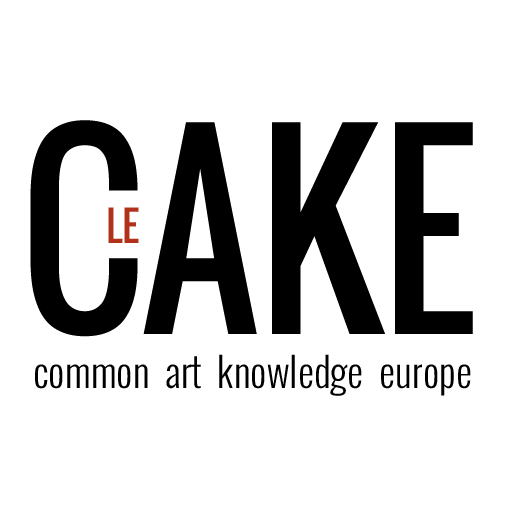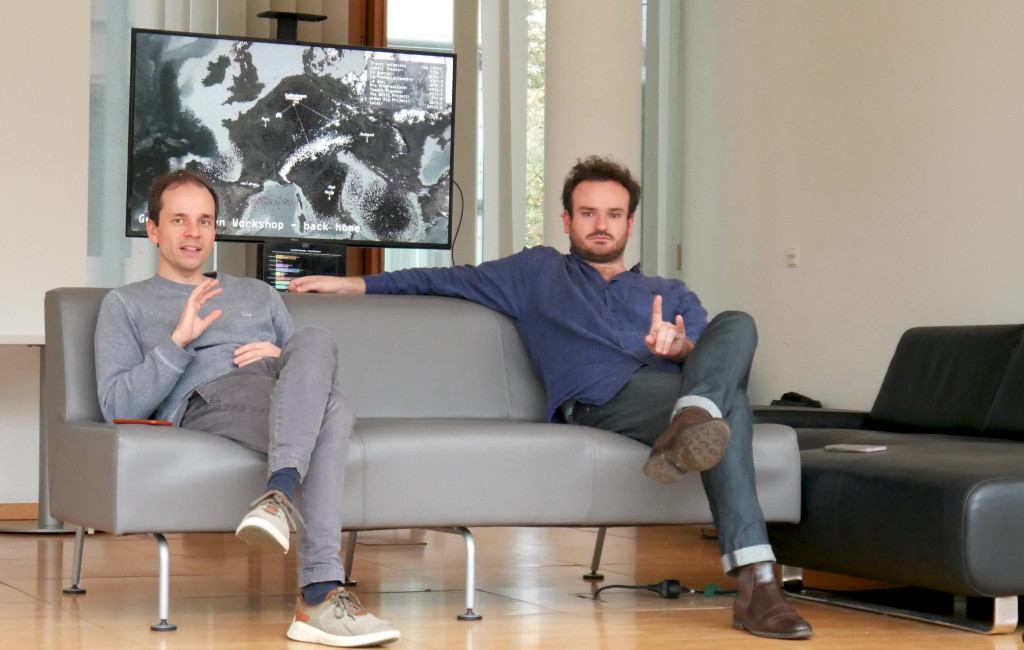Installation aesthetics
The visual aesthetics of the installation were inspired by the research and work that Charles had carried out for his Master thesis “Sur les nouveaux enchevêtrements et l’utilisation de l’imagerie en points cloud. De la crise du sensible aux regards a-modernes dans la création visuelle contemporaine.” (On new entanglements and the use of points cloud imagery. From the crisis of the sensible to the a-modern gaze in contemporary visual creation.) which considered the visual aesthetics of point clouds created from LiDAR technology in the context of contemporary visual art creation and ecological thought. The research focused on a corpus of international artists and their corresponding works. Point clouds and in particular their three-dimensional volumetric rendering of reality were studied through the lens of ecological thought as a possibility to overcome the traditional subject-object relationship established by traditional “2D” cameras.
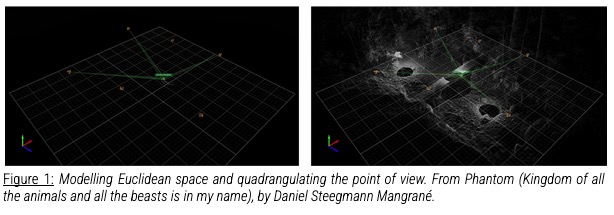
Point clouds are images composed not of a density of light on a sensitive surface as in film or digital cameras, but of a myriad of points obtained by, e.g. using a LiDAR scanner (Light Detection And Ranging or Laser Imaging Detection And Ranging). Such a scanner emits laser signals in all directions around the sensor head, registering for each pulse the Cartesian x, y, z coordinates of the surrounding surfaces it encounters in a theoretical Euclidean space. The resulting “image” is a dataset in which each point represents a unit of information whose Cartesian position is at least identified in a Euclidean space x, y, z. This dataset can then be supplemented by information relating to the luminosity (light intensity) and colorimetry of the point using a range of R, G, B. Given the amount of information generated by this method, the image is reconstructed by an algorithm.
This dissertation provided an opportunity to retrace the various issues involved in representing modernity as a visual culture historically, technically and philosophically situated. Many thinkers and art critics have denounced the limits of the ways of representing reality proposed by modernity in the context of a renewed relationship with the earth through ecological thinking. By proposing an exploration of the notion of entanglement, we have been able to gauge the conceptual fragility of the modes of representation implied by modernity, and in particular the need to stabilise the gaze in a relationship that separates subject and object. Although convenient, this way of representing reality has often become inadequate since the profound anthropological turnaround represented by the (re)discovery of our entanglement with the earth’s environment, which not only no longer belongs to us but also evolves with and above all outside our presence and actions as humans.
The second main characteristic of Perturbatio concerns its interactivity: The installation was designed to use people’s motion data (e.g. walking trajectories of many people in a large space/hallway or body and limb movements of a few individuals) which is captured using cameras and translated in real time into forces acting on the point cloud particles. The inspiration for this approach as well as the technical knowledge for its implementation came from Tim’s previous experiences at Le sas.
Development methodology
The methodology giving rise to Perturbatio can be broken up into three main stages:
- Conception:
- first ideas from pre-existing skills and knowledge (point cloud/LiDAR aesthetic discussed in Charles’ master thesis, Tim’s programming skills, interactive artworks at Le sas)
- additional inspiration, e.g. by visiting the art exhibition Palais Augmenté 3, LINK
- Technical development:
- programming of a first prototype using point clouds found online
- discussions and first tests with different audiences at Le sas and during a seminar at Sorbonne Nouvelle university
- gradual evolution of the technical, aesthetic and interactive form of the installation
- generation of custom point clouds using the artists’ smartphones and photogrammetry apps (apps that allow real-world objects to be scanned and turned into 3D models and point clouds, examples include Polycam, Scaniverse and RealityScan)
- Production/exhibition:
- planning of an exhibition during the Gelsenkirchen workshop with the local project partner Consol Theater
- download of point cloud data of the city of Gelsenkirchen (freely available from the website of the city’s geographical services)
- preparation and fine-tuning of three dedicated versions of Perturbatio for the workshop
- actual exhibition in Gelsenkirchen during two weeks at mxr Lab and during an event at Wissenschaftspark (see next section)
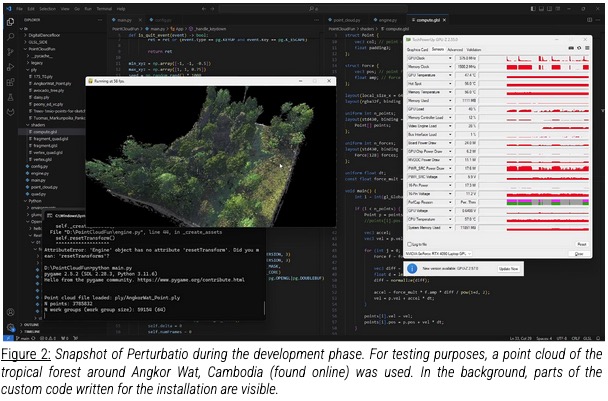
Technical description of the installation and exhibition locations
Perturbatio was developed to be flexible with respect to the final presentation form, so that it can be easily adapted to a specific exhibition context. During the Gelsenkirchen workshop, three versions (two interactive live demonstrations and a non-interactive video loop) were shown.
Live version at mxr Lab
Based in Gelsenkirchen, mxr Storytelling is an agency and development studio for digital projects, installations and artworks, focusing in particular on the use of virtual and extended reality technologies. They kindly agreed to exhibit Perturbatio in their experimental office mxr Lab (in a window facing the forecourt of the event church Heilig-Kreuz-Kirche) during a period of two weeks around the LeCAKE workshop in Gelsenkirchen (Figure 3). Moreover, they also provided most of the technical equipment for the exhibition period:
- a large screen (Iiyama PROLITE TE6568MIS-B1AG 65-inch touchscreen)
- a webcam (from artists’ stock)
- a computer (Asus laptop)
- power, HDMI, and USB cables
The version of Perturbatio exhibited at mxr Lab represented a first real-world test and was not accompanied by active communication with passers-by. Instead, the installation was framed by posters advertising for the LeCAKE pilot event held at Wissenschaftspark. The contact with mxr was made possible through the local LeCAKE partner Consol Theater.
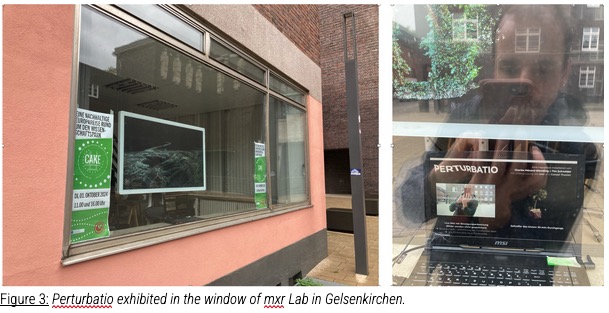
Live and non-interactive versions Wissenschaftspark
In the context of the Gelsenkirchen workshop, a pilot event called “Eine nachhaltige Europareise rund um den Wissenschaftspark” was held at Wissenschaftspark in Gelsenkirchen on October 1st, 2024. The event was divided into two sessions (a 2h morning session for primary school pupils and a 2h afternoon session for the general public) which showcased performances and installations on ecological topics prepared by the partners of the LeCAKE consortium.
Wissenschaftspark is a large multi-functional building hosting offices and laboratories as well as seminar and exhibition spaces. It is located only 300 m on foot from mxr Lab. Two versions of Perturbatio were prepared for the pilot event at Wissenschaftspark:
First, an interactive live demo (Figure 4) was exhibited, using the following technical equipment:
- a large screen (Samsung UE60J6250SU 60-inch TV)
- a camera/tracking sensor (XBox One Kinect)
- a computer (Dell Precision 7780 laptop)
- power, HDMI, and USB cables
- energy cost metre (to monitor the power consumption during the event)
This version showed different point clouds of the city of Gelsenkirchen which were manually selected by the artists and downloaded from the city’s geography data online platform. The point cloud deformations caused by the movements of passers-by and visitors were set to be fast and strong, giving rise to large bursts of particles and very noticeable three-dimensional distortions. This was done to instantly grab passers-by’s attention and to give the audience a clear feedback of the concept of the installation and their possibility for interaction. The interactive live demo represented the main version around which communication and discussions with the public were centred (see section “Interactions with the public about ecology”).
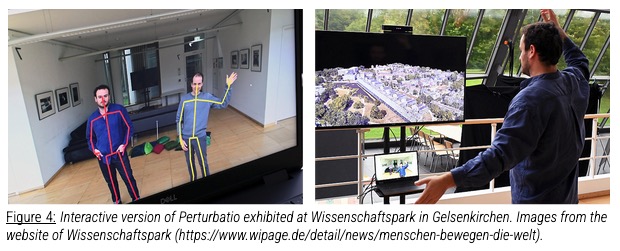
The second version presented during the pilot event was a pre-recorded (and therefore non-interactive) video using a point cloud representing a map of Europe. This point cloud map was distorted by small pictograms of planes, trains, buses etc. which moved across the map, retracing the travels done by the LeCAKE partners for each of the four in-person workshops (Figure 5). The corresponding CO2 emissions (estimated using the model mobitool-v3) were shown in a rectangle overlaid on top of the map as well as on a second screen presenting an evolving bar chart that counted the total and per-person emissions for each consortium partner (Figure 6).
The equipment used to exhibit this version of Perturbatio was:
- a large screen (Samsung UE60J6250SU 60-inch TV)
- a computer (Apple MacBook Pro)
- power and HDMI cables
- energy cost metre (to monitor the power consumption during the event)
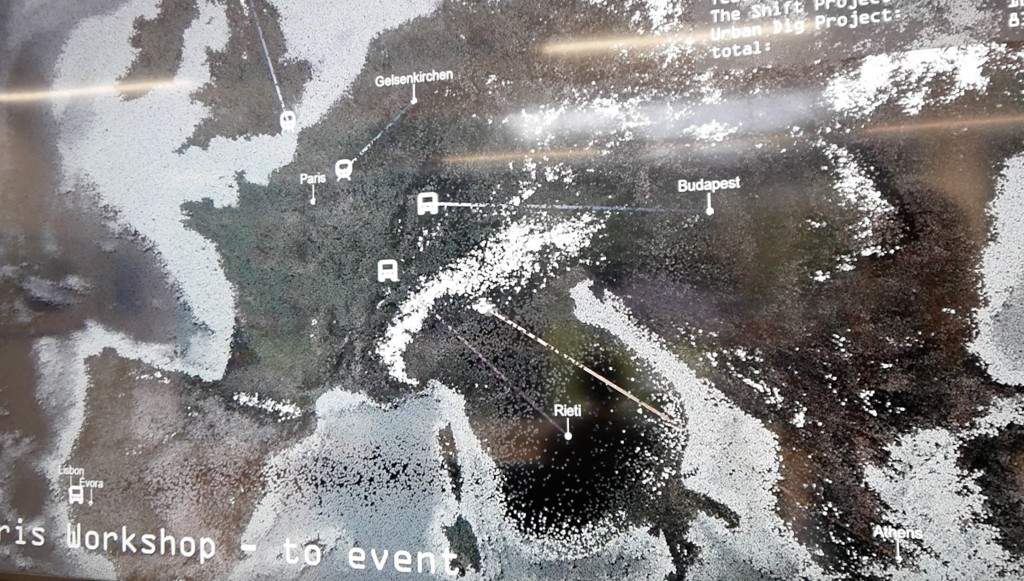
This non-interactive version was conceived as an illustration and evaluation of the LeCAKE Train project and in particular the carbon footprint associated with the in-person workshops. In this context, it served as a condensation nucleus for critical reflections and conversations with the audience about LeCAKE.
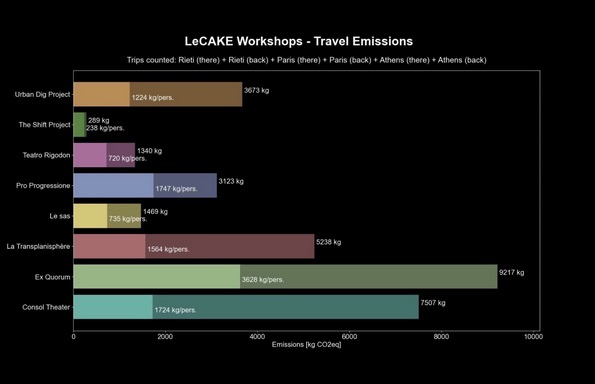
Ecological considerations
To design an art installation that minimises its ecological footprint, careful consideration of material sourcing, transportation, and logistical planning is essential. This approach begins with consideration of the production and transportation costs for the devices and material needed for the installation.
In that regard, the creative team made exclusive use of existing materials, repurposing items such as computers and a Kinect sensor from the artists’ own stock or their organisation. No devices were bought specifically for Pertubatio.
Collaboration with local partners, including mxrLab, Consol Theater, and Wissenschaftspark, ensured that large equipment, like TV screens, did not require environmentally costly transportation, as these items were already available on location.
Furthermore, the artists opted for low-impact travel by using trains and shared accommodations, reducing emissions related to their journey and stay.
Such strategic choices demonstrate how thoughtful planning and resourcefulness can significantly lower the environmental impact of an art installation while fostering creative collaboration.
All that being said, it is crucial to remember that the main CO2 emissions of an art exhibition usually come from the mobility of the audience. This is why the artists designed the installation at mxrLab so that it works on the movements of passers-by. No people had to “travel” to see the installation, rather it was enjoyed by those that are already living and going around the neighbourhood where Perturbatio was installed.
During the pilot event at Wissenschaftspark, the energy consumption of the two versions of Perturbatio was monitored using energy cost metres:
- Interactive version: 1.65 kWh
- Non-interactive version: 0.70 kWh
The total power consumption was therefore 2.35 kWh. The corresponding carbon emissions could be assessed using the website electricitymaps.com. On October 1st 2024 (i.e. the day of the event at Wissenschaftspark), the emissions value for Germany was 251 g CO2eq/kWh at 12h00 and 374 g CO2eq/kWh at 18h00. Since the event consisted of two 2h-sessions in the morning and afternoon, the mean value (312.5 g CO2eq/kWh) was used to calculate the total electricity-related emissions:
2.35 kWh x 312.5 g CO2eq/kWh ≈ 734 g CO2eq.
For a complete ecological footprint analysis, a life cycle assessment (LCA) must be performed to assess the environmental impact related to the production, transport, maintenance and disposal of the used equipment. To get a first approximation, the reference values available from the online eco-analysis tool EcoDiag were used:
- Laptop Dell Precision 7xxx: 304 kg CO2eq
- Laptop MacBook Pro 15/16 inch: 330 kg CO2eq
- Screen ≥ 32 inch: 590 kg CO2eq
Note that the listed values indicate manufacturing and transport emissions but exclude operational power consumption. For the final calculation, these values need to be weighted by a factor taking into account the use period and the expected lifetime of the devices. For the equipment used during the exhibition at Wissenschaftspark, one may assume a lifetime of 5 years and a regular use frequency of about 300 days per year, yielding a weighting factor of 1 day / 300 days / 5 years ≈ 0.00067 (1/years) and an approximate LCA contribution (neglecting the Kinect camera and cables) of:
- Laptop Dell: 203 g CO2eq
- Laptop MacBook: 220 g CO2eq
- Two TV screens: 2 x 393 g CO2eq = 786 g CO2eq
The total GHG emissions, including power consumption and LCA aspects, attributable to the exhibition of Perturbatio during the event at Wissenschaftspark therefore amount to roughly 1.9 kg CO2eq. To put this into perspective, should Perturbatio be exhibited for a longer period of time of, e.g., 3 months (90 days), 8 hours a day, this would equate to roughly 203 kg CO2eq. In comparison, this is equivalent to approximately 1000 km by car (combustion engine).
It was first planned to do the same analysis for the version of Perturbatio exhibited at mxr Lab. In the end, however, it could not be carried out due to technical problems with the energy cost metre. One may expect a footprint and consumption similar to that of the live version exhibited at Wissenschaftspark.
